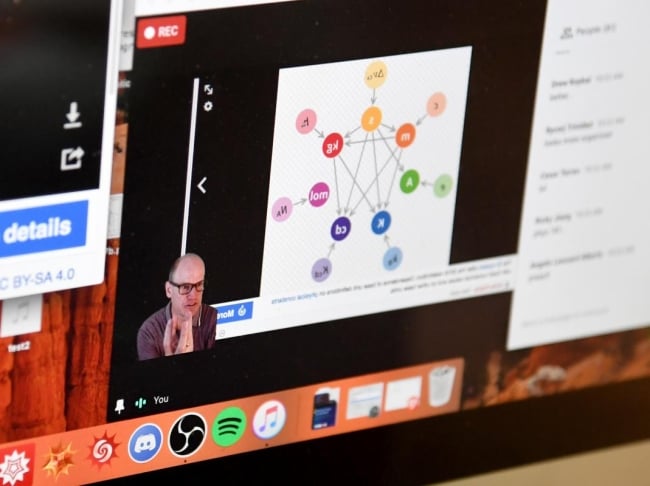You have /5 articles left.
Sign up for a free account or log in.

A new survey examines faculty attitudes toward teaching STEM courses online.
Ethan Miller/Staff/Getty Images
Faculty members in science, technology, engineering and mathematics conduct some of the most technologically groundbreaking research in all of academe, but when it comes to teaching online, STEM has historically lagged behind.
The findings of a new survey, STEM Education in the Time of COVID, suggest that hesitancy to embrace online education may be changing.
Bay View Analytics, a statistical research firm, published the report with the Online Learning Consortium, a membership organization that promotes the use and quality of digital education. The report was supported by Every Learner Everywhere, a network of organizations that promotes online education with a focus on equity, as well as three companies involved in distance education in STEM: Digital Ed, Carolina Distance Learning and HHMI BioInteractive.
“STEM faculty are now cautiously optimistic about the future of online STEM education,” Jeff Seaman, co-director of Bay View Analytics, said in a statement. “This suggests they may reassess how STEM education is delivered and be more open to new approaches that incorporate online education and digital learning into their curricula.”
The STEM survey was initially scheduled to be completed in March 2020, just as the COVID-19 pandemic began forcing U.S. colleges to move to remote instruction, Seaman said. That shift to remote delivery prompted a completely new approach to the survey, which was completed in fall 2020, he said.
The survey includes responses from 896 instructors at a range of two-year and four-year institutions.
A majority of respondents, 73 percent, reported transitioning from face-to-face to remote teaching during 2020, despite more than a third never having taught online before.
The faculty members reported many barriers to success in online learning that are not problems specific to STEM. The biggest perceived barriers to successful online education survey respondents reported were concerns about academic integrity and a lack of student motivation to engage with online coursework.
Instructors in STEM fields appear to have unusually high concerns about students cheating in assessments, Seaman said.
When you ask students to provide a definition or calculate the answer to an equation that is commonly found in textbooks, cheating is, unfortunately, more likely to occur than if you asked students to analyze, synthesize and apply their knowledge, said Stephen Thomas, a curriculum designer at Michigan State University who has over a decade of experience teaching STEM online.
But Thomas has seen faculty members trying to adapt.
“I’m amazed at how dedicated faculty have been in trying to make not just comparable experiences online, but also enriching experiences,” Thomas said. “We’ve had faculty really re-engaging with their curriculum to try and leverage the affordances of online learning -- especially around assessment.”
Some faculty members have completely rethought how to assess their students, Thomas said. Rather than relying on high-stakes exams or asking questions with answers that can easily be found on Google, some instructors are conducting more frequent assessment that asks students to apply their knowledge to specific situations, he said. That said, there are also instructors who have leaned on online proctoring tools to try and carry out the same assessments they did before.
“When it comes to academic dishonesty, the answer rarely boils down to a single technology,” Thomas said. “There are instructors who think, ‘Oh, if only we had the perfect online proctoring system, we’d be able to prevent cheating.’ But academic dishonesty comes from a suite of variables.”
Survey respondents reported one widespread and discipline-specific concern about delivering STEM education online: how to translate in-person, hands-on laboratory experiments into meaningful remote experiences.
While many faculty members shared optimism about the potential to use online tools to simulate lab experiences, just 18 percent of survey respondents reported having used such tools in their coursework. Some 35 percent of respondents said they were aware of online labs but felt they didn’t meet their instructional needs.
For decades, STEM faculty members have been wary of online education, particularly when it comes to simulating lab experiences online, said Devon Cancilla, an online learning consultant who was involved in the development of the report as a former staff member at the Online Learning Consortium.
In the shift to remote learning, faculty experimented with a range of solutions. Some institutions mailed lab kits to their students so they could test using equipment in their own homes. Others continued in-person labs on a staggered basis. Some embraced online lab simulations and videos -- of which there are a plethora available for free and for purchase, Cancilla said.
One of the problems that instructors have with embracing online lab options is that they don't know where to find them, according to both Cancilla and Seaman. At present, there isn't a one-stop shop where instructors can browse and compare STEM online learning resources, they said.
The Online Learning Consortium hopes to become a central resource for instructors interested in online education in STEM, said Jennifer Mathes, its CEO. By bringing more STEM courses online, there is a possibility that the field might open up to a broader range of students who value the flexibility of learning on their own time. But this is a research question that needs to be further explored, she said.
"We know that women, racially minoritized students, and students from lower-income brackets leave STEM fields at higher rates," Mathes said. "We need to do more research in this area to answer the question of whether this would create a more equitable learning environment for students."




